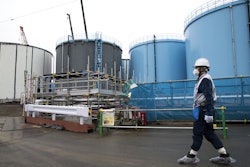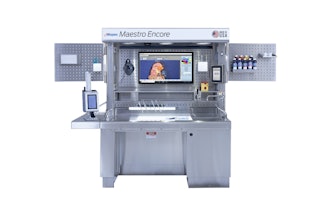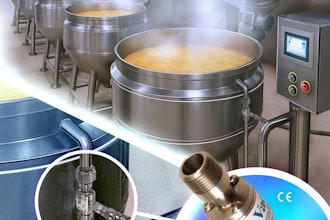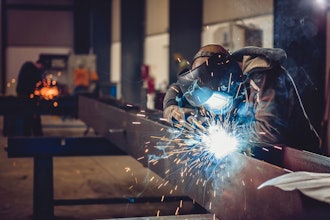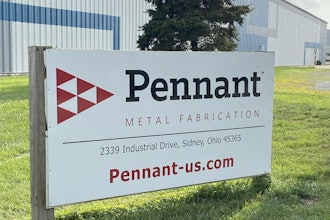How many horsepower do I need? Should I buy a direct drive or gear-driven mixer? What size and type of impeller works best? These are just some of the questions that people ask when looking for an industrial mixer. For those experienced with production of liquid products or design of continuous flow processes the answers may be familiar; but what about the professional who has an infrequent or even a one-time need to set up a batch mixing system? The apprehensive engineer whose core duties do not normally include mixing systems can benefit from understanding some basic concepts as well as from the guidance of an industrial mixer manufacturer’s rep or applications engineer.
While a surplus tank from a past project paired with an old mixer from the maintenance department may be convenient and inexpensive there is another key result to consider: good mixing. Therefore, the following is offered as a foundation for sizing up common industrial mixing needs.
A simple definition of the term “mixing” is the combining of different materials (liquids, gases, solids) to produce a homogeneous mixture commonly achieved with a rotating shaft and impeller. More specifically, the change in positional relationship of two theoretical “particles” in a mixing tank occurs in the “zone of attrition”, the highly turbulent region at the impeller’s trailing edge. Therefore, the successful mixing system design ensures uniform distribution of ingredients through frequent exposure to the mixing impeller.
All industrial mixing applications consist of a combination of flow and shear. Material flow is the quantified liquid movement resulting from an impeller’s pumping capacity. Mixing engineers calculate pumping capacity in units including tank turns per minute, bulk fluid velocity and agitation scale, a 10-point system rating agitation from mild to violent. The material flow pattern can be thought of as the visualization of how and where the material flows throughout the mixing vessel. It is influenced by the relationship between the impeller and vessel geometry, not simply by the batch volume. A large impeller rotating slowly and a small impeller rotating fast may have equal pumping capacities but will provide significantly different flow patterns. Fluid shear is the change in velocity gradients along the profile of the impeller. Shear rate is a characteristic of the impeller design or type and can be thought of as how “aggressive” it is at its operating speed. Low shear is desirable for shear-sensitive ingredients or mixtures whereas high shear may be required to achieve the desired outcome when using immiscible liquids or for suspending higher density solids.
Armed with the basic understanding of what effective mixing is and the concepts of flow and shear the following is a working list of prerequisite information and design guidelines used by industry professionals:
- Batch volume (include maximum and minimum batch, if applicable)
- Vessel diameter, overall height & liquid depth
- Vessel geometry (flat bottom, cone bottom, elliptical head)
- Material properties
- Viscosity
- Specific Gravity (or weight/gallon)
- Solubility & concentration of solids, if applicable
- Corrosive or flammable properties
- Desired process result (blended liquids, suspended solids, etc.)
From the above, the optimal theoretical design, i.e. the combination of impeller type, size and speed in relationship to the vessel to provide the required material flow pattern and agitation level is selected. Normally, simple blending applications utilize marine style or hydrofoil impellers as they pump liquid very efficiently. More viscous materials often call for an axial flow turbine, sometimes also referred to as a pitched blade turbine. These impellers feature wide, flat blades at a 45-degree angle for increased surface area in contact with the liquid. It is at this point that the mixer horsepower and torque can be calculated enabling selection of the motor and gearbox (if one is required).
Figure 1. demonstrates a common setup for mixing low viscosity liquids in a cylindrical tank where:
- T = Tank Inside Diameter
- Z = Liquid Depth
- D = Impeller Diameter
- C = Impeller Distance from Bottom
- B = Tank Baffle Dimension
- W = Impeller Blade Width
General guidelines are that a liquid depth to diameter ratio (Z:T) of 1.0 works well with a single impeller located one impeller diameter off the bottom (C = D). For a Z:T ratio higher than 1.2 a second impeller is often added at a distance of about one impeller diameter above the first one. An impeller to tank diameter ratio (D:T) of .33 is a good starting place for an effective flow pattern for lower viscosities. Higher viscosities may require a D:T of .66 or higher.
Tank baffles are optional but common to prevent low viscosity liquids from simply swirling around the tank in a center-mounted configuration. Typically sized at 1/12 of the tank diameter, they serve to increase turbulence and therefore improve the mixing result. Another practice to improve mixing vessel turbulence is to locate the mixer off-center and at a 10 to 15-degree angle from vertical. For smaller, more portable tank sizes, a clamp mounted mixer is often used.
These general guidelines apply for axial flow mixing systems, i.e. where flow is in the direction of the mixer shaft. Flow created by the impeller is normally downward resulting in return upward flow along the tank walls and back to the center. A vortex may or may not be desirable and is determined by the intensity of the agitation.
Overall, mixing applications in industry range from very simple to quite complex. A wide variety of equipment may work for low viscosity miscible liquids or with highly soluble solids. However, as viscosity, solids concentration and dissimilarity of batch ingredients increase so do the complexities of the system considerations to achieve a successful process outcome.
Mark Hennis is president at Indco, Inc.






